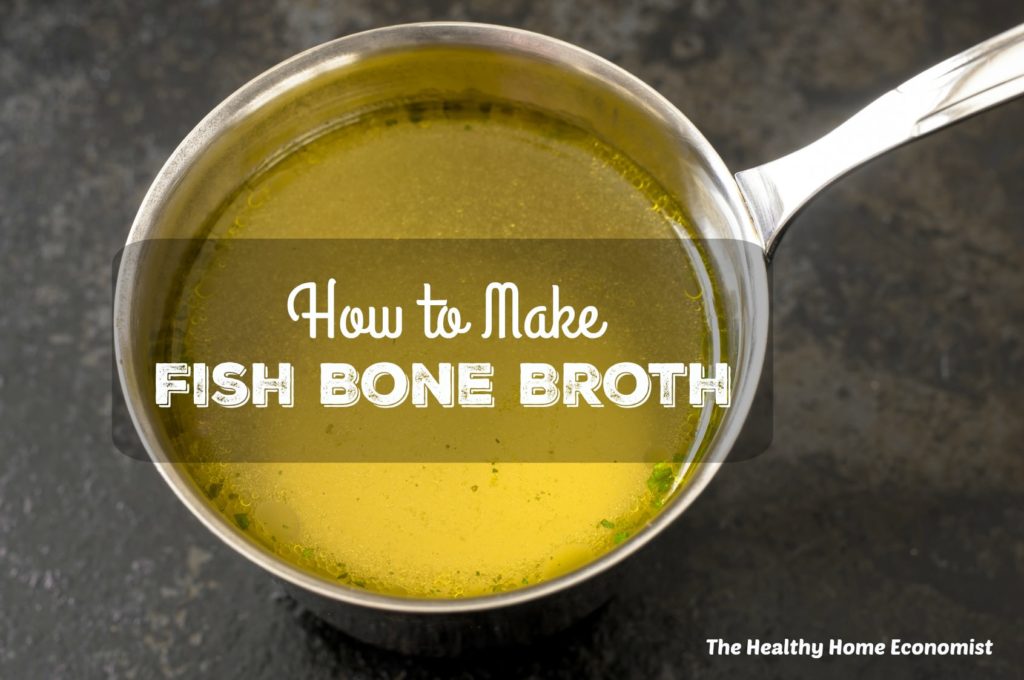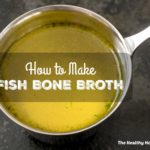
In all my years helping folks transition their wayward eating ways back to the tried, true and traditional, I have discovered that homemade fish broth or stock consistently ranks as one of those kitchen activities with a “ain’t no way I’m going to do that” sign attached to it.
So, here I am doing a video on how to make fish stock!
Though most people have no desire to make it does not change the fact that it is the most nutritious and best broth of all.
Seriously, though, making fish stock is a very important activity that should be incorporated into the routine of any cook focused on nutrient-dense cooking.
As mentioned earlier, fish stock is the most nutritious stock that you can make. Not only is it the most nutrient-dense, but it is also the most inexpensive and one of the quickest! In addition, it tastes the best too, in my humble opinion. I’m sipping a cup of red snapper stock as I type this!
I just LOVE fish stock compared to other types of homemade bone broths. Perhaps this is from my travels in Asia back in the late 1980s when I would have a cup nearly every morning as part of my traditional Japanese breakfast. I did not see fish stock in China, but I’m sure it’s there somewhere.
Homemade Fish Broth
Making fish stock is very simple and easy. A few quarts of water, a fishhead or two (plus some bones if you have them) and some vinegar. A gallon of fish stock will only set you back about $2 and be ready in only 4 hours. This compares with $20 or so for the leftover bones of a pastured chicken (and 24-48 hours of simmering) or $10-20 for 5 lbs of grassfed beef bones (and 48-72 hours of simmering).
Don’t get me wrong – I make ALL kinds of homemade stock. Each one has its own unique flavor and adds something special to your cooking repertoire of soups and sauces.
Fish Stock: Most Healing and Helpful for the Thyroid
Fish stock, though, genuinely ranks as the most healing of all stocks. “Fish stock will cure anything” and “Good broth will resurrect the dead” are both South American proverbs. (1)
Unlike other types of stock, bone broth from fish contains thyroid strengthening properties when the fish heads are included in the broth making process. Who doesn’t need a thyroid boost with the crazy, stressful lives we all lead today?
So, find yourself a quality fishmonger in your city or town and make this vitality strengthening food for yourself and your family!
The video included below demonstrates the easy process of making homemade fish bone broth yourself. Try making a pot this week and enjoy the amazing health benefits of fish broth enjoyed by many ancestral societies.
If you need a pot of fish stock even faster, this article shows you how to make bonito broth from bonito flakes.

Homemade Fish Bone Broth Recipe
Basic recipe for how to make fish stock that is the most economical, fast and nutritious of all types of bone broth.
Ingredients
- 3 quarts filtered water
- 2 lbs fish heads and/or bones non-oily fish is optimal
- 1/4 cup apple cider vinegar
- sea salt to taste
Instructions
-
Place water and fish heads/bones in a 4 quart stockpot.

-
Stir in vinegar while bringing the water to a gentle boil.
-
As the water first begins to boil, skim off any foam that rises to the surface. It is important to remove this foam as this is impurities and off flavors.
-
Reduce heat to a simmer for at least 4 hours and no more than 24 hours.
-
Cool and then strain into containers for refrigeration. Freeze what you will not use in one week.
Recipe Video
Recipe Notes
You may substitute homemade apple cider vinegar for store bought if desired.
It is recommended not use oily fish such as salmon for fish stock or you will stink up the whole house! Non-oily fish such as sole, turbot, rockfish or, my favorite, snapper, is best. I've also used grouper in a pinch, but the stock does not taste quite as good.








Excellent video and good suggestions! I’d always heard that it was the gills in salmon that made the stock less palatable, Anyhow, I left out the salmon and used striped bass, its head and backbone, and clams. I removed the foam — definitely this makes a difference! No scent of fishiness whatsoever, and I’d been in a separate part of the house for part of the cooking process. I also followed the suggestion to leave out veggies and seasonings (with the exception of a chunk of onion, if only because anything I can imagine that I will do with this stock in the future will involve onions). Very nice video! I am looking forward to a variety of soup possibilities!
Hi Sarah,
You are amazing. I love your blog.
Can you tell me, what do you do with the remaining fish head in the soup?
Thank you!
Hi Jennifer, you mean after the fish stock is made? I toss the fish head in the trash as all the good stuff has come out and is in the fish stock at that point.
if you grind up the fish bones they makes great fertilizer!
If your city doesn’t have a yard-waste collection system where they allow you to throw any and all food scraps in (including bones and fish heads), you can do it yourself at home.
It is called Bokashi (google or youtube for it) and uses a special combination of yeast, lactobacillus bacteria and photosynthetic bacteria to ferment (vs. compost) kitchen waste right in your kitchen. It is a closed system that produces no bad smell (unless you don’t like the smell of fermented vegetables). You use a bucket with a tight lid and a spigot drain, place the Bokashi starter in it, place your kitchen scraps on top and layer each 2 inch layer of scraps with a thin layer of Bokashi. When the bucket is full, you leave it alone for 2 weeks, then bury the fermented scraps in your garden or backyard where soil microorganisms will completely it breakdown in another 3-6 weeks and be VERY nutritious to add to your houseplants or garden. If you put a lot of animal products in the bucket system, simply use more Bokashi as animal products are more difficult to ferment. The system was developed in Japan and has been used since 1980.
I realize this system won’t be for everyone, but it really is superior to composting. And anyone who has composted animal products know the smell and pest problem it can create! Superior in that fermenting the scraps does not produce the amount of CO2 gasses that composting will do. Also superior in that the fermented product is more nutrient-dense for growing things than compost is.
Hi Sarah,
I made a fish stock last night from red snapper from my local fish market. The fillets we ate for dinner and while it didn’t taste or smell bad, when cleaning the fish, I thought one didn’t smell/seem as fresh, but thought it was just me, since I just bought them. Well, while simmering the stock, the whole house smelled VERY fishy! The stock turned out very nice looking and gelatinus, but the fish smell is so strong, wonder if it is bad, or if the fish was going bad. How can I tell with nothing to compare it to. Should I still try to use it, or toss it?
Hi Geebee, you’ll have to use your best judgment on that one.
That happened to me as well… The smell was so nauseating, I couldn’t take it and threw it away.
Hi Bethany, no gelling stock is usually caused by too much water. You can boil it down and it should gel nicely. Non gelling stock is fine to eat its just watered down.
Do you know why fish (or other stock) sometimes does not gel? I have made fish stock about 4 times and it about half the time it does not gel. Once it made a nice gelatin with the snapper and the next time it did not. I've had the same experience with grouper, so it does not seem to do with the type of fish. I've had the same problem with chicken, but in that case I think I cooked it for too long at too high a temp. But I was careful not to let my fish stock get too hot, but maybe I didn't let it simmer at a high enough temp? I kept looking for the blub, blub, blub and would turn it up a little if I didn't see it. I cooked it for a little over 4 hours with 2 huge grouper heads and a little over 3 quarts of water, but no gelatin. If it tastes okay is it still beneficial to eat?
bethany
I think the snapper stock tastes way better than grouper stock and I've never had to take scales out of it either. Not sure what they are talking about there, but I guess it comes down to personal preference.
Sarah- I am a little confused. I called my fish monger and they have grouper and snapper heads for cheap so I asked if they were cutting snapper today, they said No, but they had grouper heads. I said no thanks, I will wait for the snapper because I want to make a stock. The guy said they make grouper stock all the time and it is much better than snapper. He said it produces more gelatin (I guess) and it does not have scales which if you use snapper, you will have to remove the scales from your stock.
Is this true? Anyway, I am just gonna try the grouper today (this is the first time I have ever made stock!) and if we don't like it I will try the snapper.
Thank you so much for this video, Sarah! I found my fish monger and am going out to get my fish heads soon!
Hi Janetlynda, if the bones are pretty bare, it should be fine. If you are happy with the fish stock from an oily fish, wait until you try it with snapper – you will go wild it is SO GOOD!
Hi Bethany, glad you finally took the plunge with the fish stock. Yes, I also find my back feels like a 20 year old also when I drink fish stock regularly. It is more powerful than other stocks and is my definite favorite. So many people are missing out by not making it!